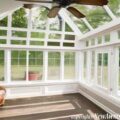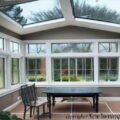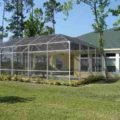Last Updated:July 22, 2024
Types of Aluminum Sunroom
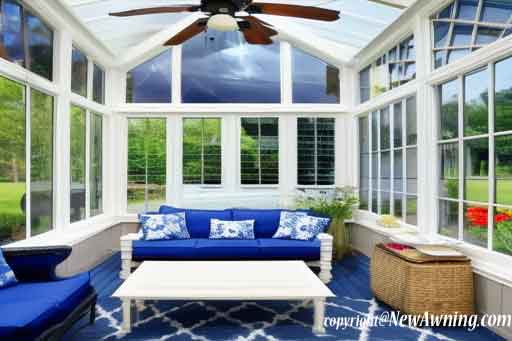
Aluminum sunrooms are a popular choice for patio enclosures because they are durable, low maintenance, and energy efficient. They provide a comfortable, protected space to enjoy the outdoors, while also allowing you to enjoy natural light and views. There are several different types to choose from, each with its unique features and benefits where you are having one custome built or using a sunroom kit. In this blog post, we will explore the different options and help you decide which one is best for your needs.
Traditional Aluminum Sunroom
Traditional sunrooms with aluminum frames and white vinyl siding are the most common type of sunroom, and they are often used to enclose an existing patio or deck. These sunrooms feature a solid roof, walls made of glass or screen, and a foundation made of concrete, wood, or aluminum. Traditional aluminum sunrooms can be attached to your home or freestanding, and they can be custom designed to fit your specific needs and preferences.Pros:
- These are the most affordable option, making them a good choice for those on a budget.
- They are relatively easy to install and can be done in a matter of days or weeks, depending on the size and complexity of the project.
- They provide year-round protection from the elements and can be used as a comfortable living space.
- They are energy efficient, as they allow natural light to enter the room and can be equipped with energy-efficient windows and doors.
Cons:
- This type of sunroom may not be as durable as other types of sunrooms, as they are vulnerable to weather damage and may require more maintenance.
- They may not be as aesthetically pleasing as other types of sunrooms, as they have a more industrial look.
Studio White Aluminum Sunroom
Studio sunrooms are similar to traditional ones, but they have a more modern and sleek design. These sunrooms feature a sloping roof and walls made of glass, and they can be attached to your home or freestanding. They are a good choice for those who want a sunroom that is both functional and stylish.Pros:
- Studio sunrooms have a more modern and stylish design than traditional designs.
- They allow for a lot of natural light to enter the room, making them a bright and airy space.
- They can be customized to fit your specific needs and preferences, and they can be equipped with energy-efficient windows and doors.
Cons:
- They may be more expensive than traditional sunrooms, as they have a more complex design.
- They may require more maintenance, as the sloping roof may be prone to leaks or damage.
- These can be viewed as generic or cookie cutter by many potential homebuyers
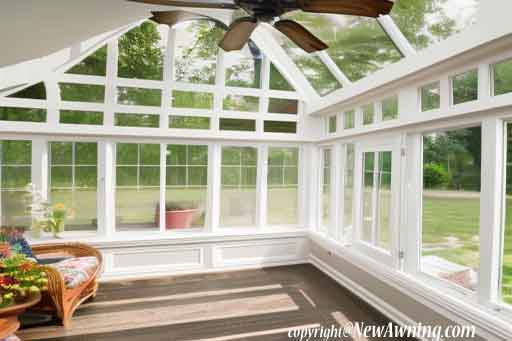
Three-Season Aluminum Sunrooms
Three-season sunrooms are designed to be used during the spring, summer, and fall months, as they are not insulated for winter use. These sunrooms have a solid roof, walls made of glass or screen, and a foundation made of concrete, wood, or aluminum. Three-season aluminum sunrooms can be attached to your home or freestanding, and they are a good choice for those who want to enjoy the outdoors without being exposed to the elements.Pros:
- These are less expensive than four-season sunrooms, as they are not insulated for winter use.
- They protect from the sun, wind, and rain, and they allow you to enjoy the outdoors in comfort.
- They can be customized to fit your specific needs and preferences, and they can be equipped with energy-efficient windows and doors.
Cons:
- They are not suitable for use during the winter months, as they are not insulated and may not be able to withstand cold temperatures.
- They may require more maintenance, as the windows and doors may need to be removed or covered during the winter.
- These may not count towards your homes overall square foot listing in MLS
Four-Season Aluminum Sunrooms
Four-season sunrooms are designed to be used year-round, as they are fully insulated and equipped with heating and cooling systems. These sunrooms have a solid roof, walls made of glass or screen, and a foundation made of concrete, wood, or aluminum often with vinyl covering. They can be attached to the exterior of your home or freestanding, and they are a good choice for those who want to use their sunroom as a comfortable living space.Pros:
- They are suitable for use year-round, as they are fully insulated and equipped with heating and cooling systems.
- They protect from the elements and can be used as a comfortable living space.
- They can be customized to fit your specific needs and preferences, and they can be equipped with energy-efficient windows and doors.
Cons:
- These are more expensive than three-season sunrooms, as they are fully insulated and equipped with heating and cooling systems.
- They may require more maintenance, as the heating and cooling systems may need to be serviced or repaired.
Solarium Aluminum Sunrooms
Solariums are similar to four-season sunrooms, but they have a fully glazed roof that allows for maximum natural light to enter the room. Some of our readers call these a “glass sunroom” or “conservatory”. These sunrooms have walls made of glass or screen, and they can be attached to your home or freestanding. We’ve seen many of these in Florida and North Carolina. They’re a good choice for those who want a sunroom that is bright and sunny all year round.Pros:
- Solariums are bright and sunny all year round, thanks to the fully glazed roof.
- They protect from the elements and can be used as a comfortable living space.
- They can be customized to fit your specific needs and preferences, and they can be equipped with energy-efficient windows and doors.
Cons:
- Solariums are more expensive than traditional sunrooms, as they have a fully glazed roof and may require more materials.
- They may require more maintenance, as the glazed roof may be prone to leaks or damage.
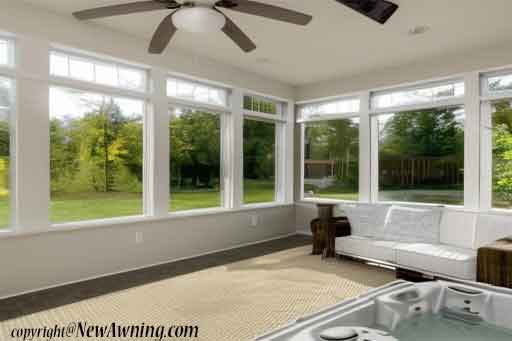
Enclosed Patio
Enclosed patios are when an existing patio has aluminum support frames often with vinyl over it placed from the wall to the roof. Some people refer to this as a porch-view sunroom. From there, either screens or windows are placed to define the space. These are not attached to the HVAC system so they are neither heated nor cooled. They also rarely have indoor flooring so we always suggest having a few outdoor rugs or indoor outdoor carpet to help the room feel more comfortable unless you plan to wear shoes all the time.Pros:
- Enclosing a patio is a very DIY-friendly project.
- These are the most budget-friendly option which can often be completed for under $1000 in many areas when the homeowner provides the labor.
- In many areas, these require no building permit although we always recommend checking before you make a change.
Cons:
- Enclosed patios may not count toward your home’s overall square footage when you list it with a realtor.
- You will often need outdoor rugs to add some insulation to the floors otherwise it’ll be very cold in the winter months.
- The screens or windows can be easily broken if theft or home invasions are a concern in your area.
Conclusion
In conclusion, there are several different types of aluminum sunrooms to choose from, each with its unique features and benefits with distinct reviews. Traditional sunrooms are the most affordable option, while studio sunrooms have a more modern and stylish design. Three-season rooms are suitable for use during the spring, summer, and fall, while four-season sunrooms are suitable for use year-round. Solariums are bright and sunny all year round, thanks to the fully glazed roof.When choosing, it’s important to consider your budget, needs, and preferences, as well as the climate in your area. You will also want to learn the proccess of adding a sunroom to your home. I hope this information has been helpful while you are deciding which option is best for you, your family and your home.

